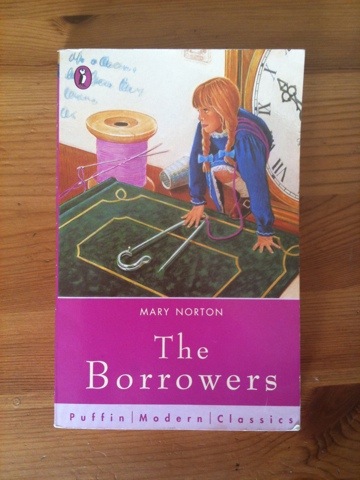
I’ve just finished Mary Norton’s The Borrowers, a children’s novel about a family of tiny people who live in the holes and cracks and under the floorboards of a great country mansion near Leighton Buzzard. The mansion and the people in it have seen better times and the Borrowers themselves may be the last of their kind. Like so many things in the book, this is left unresolved. WARNING: If you don’t know the story, there are spoilers ahead.
Mary Norton grew up at a time when women were first entering the workplace in large numbers, when the world was exploding in war and when class divisions were being, if not breached, at least challenged and exposed. She was a (failed) secretary, actress, housewife, war-worker and writer. She’d earlier published The Magic Bedknob (1943, later made famous by Disney as Bedknobs and Broomsticks). The Borrowers (1952) was an enormous popular success, leading to several sequels, TV adaptations and films. Studio Ghilbli have just released Arrietty, which I’m looking forward to seeing immensely and a live action BBC adaptation is due later this year.
I never read The Borrowers as a child. If I had, I probably would loved the realism she poured into the lives of rebellious teen Arrietty, her aging father Pod and her anxious, house-proud mother, Homily. I would have (as I did earlier today) devoured the last forty pages at one sitting as their lives are literally torn apart. I might have missed how sensitively she handles the the friendship between the Boy in the story and Arrietty but I still would have ached for both of them.
As an adult and a would-be writer other things struck me, like Homily’s desperate, neurotic need to ‘better’ herself, rooted in her long-standing envy of another, vanished, Borrower family. Ultimately, it’s a mixture of her greed or longing or insecurity, combined with the Boy’s well-meaning kindness which leads to the catastrophe that destroys their home. They get ideas above their station in life. In the case of Arrietty, the only one who can read and write, this is physically embodied in the relationship she forms with one of the giant ‘human-beans’. Through him, she discovers the true, devastatingly minor status of the Borrowers in a world which turns out to be a human world, not a Borrower world.
I could go on about this at length and Mary Norton is not unusual in exploring these themes. But there are tougher, more important things going on here.
In Conrad’s Heart of Darkness, an anonymous narrator relates a story told by the old East Africa hand, Marlowe. In The Borrowers, Norton’s narrator is equally anonymous (though decides to call herself ‘Kate’) whilst the Marlowe figure is an old woman called Mrs May whose brother – the Boy – told her the story of his encounter with the Borrowers. Little hints of unravelling Empire lap around the edges of the story. Her brother (“he was our little brother”, Mrs May says, in a heart-breaking aside) eventually dies a hero’s death on the North West Frontier. But perhaps he’d already seen the worst humanity has to offer as a child in witnessing the savagery the grown-ups gleefully unleash on their tiny house-guests. Towards the end of the story, the hideous housekeeper Mrs Driver, having uncovered the Borrowers, harangues him:
“Once you’ve found the nest,” she went on, her voice dropping to a vicious whisper as they passed Aunt Sophy’s room, “the rest is easy.”
To her, the Borrowers are less than human – mice, rats, vermin to be exterminated – “Nasty, crafty, scampy, scurvy, squeaking little…”.
But there’s worse to come. “Exterminate the brutes,” was one of Kurtz’s last diary entries. But ‘extermination’ had a different resonance for writers in the late forties.
In a horrible (but understated and painstakingly described scene) the ratcatcher, a man who makes his living out of the killing sub-contracted to him by others, meticulously seals up every hole and escape route in the house and pumps gas into their hiding places as the village policeman, the gardener and Mrs Driver watch and joke. For a writer who’d lived through World War II this could only have one terrible parallel and in other places Mary Norton makes it clear that Mrs Driver knows she’s killing sentient beings. “She’ll change her tune when I take them up afterwards, laid out in sizes on a clean piece of newspaper…” The parallel to the photographs, widely published at the time, of bodies of human beings stacked like wood in the death camps is unmistakable.
But this is a children’s book and it’s possible – only possible, mind you – that the Borrowers escaped. Mrs May is not the most reliable of narrators and she keeps us guessing. But, really, the Borrowers were real, real enough for her to go on and write four sequels, though its hard to see how they could have the sheer force, magic and darkness of the first.


August 27th, 2011 at 5:24 pm
I haven’t finished “Just Kids” yet (which, by the way, I’m enjoying very much) and now I want to read these two. Don’t write about any more books for a while please, especially when you write so compellingly about them.
August 27th, 2011 at 8:31 pm
This is the first novel I ever read. I can only remember parts of it now.
August 30th, 2011 at 11:48 pm
I remember reading this as a child and loving the Borrowers, though I don’t remember the details of the plot and I’m sure the darkness escaped my 10-year old self. I’ve been meaning to re-read this for years. Perhaps soon.